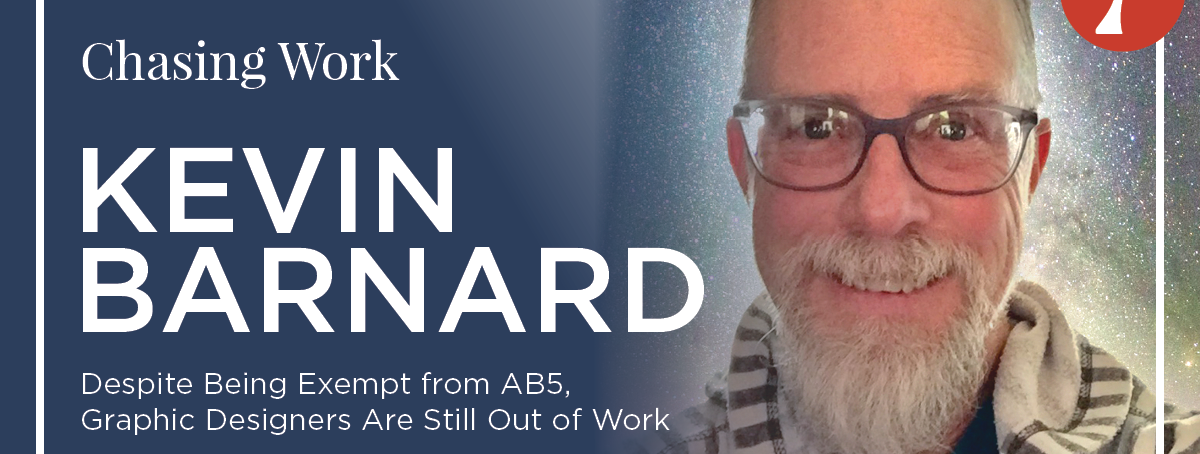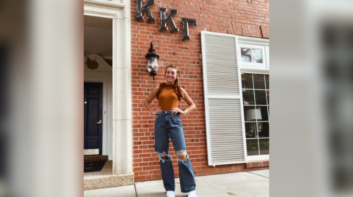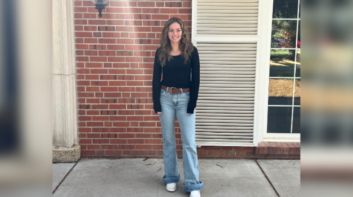“I’ve had exactly zero work in 2020 due to the perfect storm of AB5 and COVID-19.”
Kevin Barnard heard his calling as a graphic designer early on. During his teen years, he started realizing he had a talent for design and layout. He worked at his high school newspaper and gained some experience in the field.
Fast forward to his mid-20s and Barnard got a job as an art director creating graphics for in-store display work. Kevin had a generous mentor who gave him the opportunity to design seasonal display graphics for an entire 26-store retail chain.. That was when he became aware of the industry of graphic design as a career option for an artist.
In the 80s, the business of graphic design looked much different than it does today. Kevin’s work was to analyze current trends in the fashion industry and then incorporate those influences into his visual merchandising designs. When the internet emerged as a viable communications media in the mid 90s, it provided a completely new toolbox to graphic designers.
At age 29, Barnard moved to San Francisco where he’s been working for more than 30 years. In the early 90s, Barnard started working as a freelancer. As he describes his work choice: “Once I got into the habit, freelancing seemed the best option.”

“It’s a matter of freedom.” He continues: “I prefer my freedom to choose when and how I work. I seek out those kinds of clients that are comfortable with me working remotely. I choose to work at my home office and go on location when required to by the client.”
When California’s anti-freelancer law known as AB5 went into effect on January 1, 2020, Barnard’s entire work opportunity landscape became decimated. He says that the graphic design community is now trying to figure out what’s next, because freelancers are unable to find work outside of California.
Because of AB5, an out-of-state client dropped Kevin from their Preferred Vendor list, citing their relationship with Barnard as an independent contractor and potentially being audited by the state of California EDD. He says that the client was a potential $25K-35K source of income for him. He explained to their HR department that graphic designers are exempt from AB5. But despite his explanation, the client refused to reinstate him as a preferred contractor, writing in an email: “Because of AB5, the risk of legal action and fines brought by the State of California prevents us from accepting any further invoices from you.”
According to Barnard: “AB5 has all but destroyed our work environment as freelancers in California. AB5 hit me (and about 3 million other California independent contractors) smack in the face three months before the COVID-19 quarantine caused my local San Francisco clients to shutter their doors. I’ve had exactly zero work in 2020 due to the perfect storm of AB5 and COVID-19.”

He would usually have a variety of projects to sustain him. Kevin produces experiential marketing design for large conferences, but all of those opportunities have disappeared with the advent of COVID-19 quarantine and related venue closures. His Bay Area clients have closed their offices. A small number of businesses that have remained viable on the convention space are now producing online events, which Kevin has minimal expertise in.
Barnard says that AB5 has had a ripple effect across hundreds of industries and professions. “What we are seeing today is a lot of damage to work opportunities by relation. It’s not just Uber and Lyft being affected. It’s everything around being forbidden to work as a freelancer because of AB5.”
Kevin continues looking for work as a graphic designer and has produced a few independent movie soundtrack projects over the last few months, but says these “pittance projects” won’t pay all the bills. Currently, Barnard is relying heavily on a dwindling savings account. He and his wife have considered moving out of state. At the moment, they’re just trying to figure out how to make ends meet.










